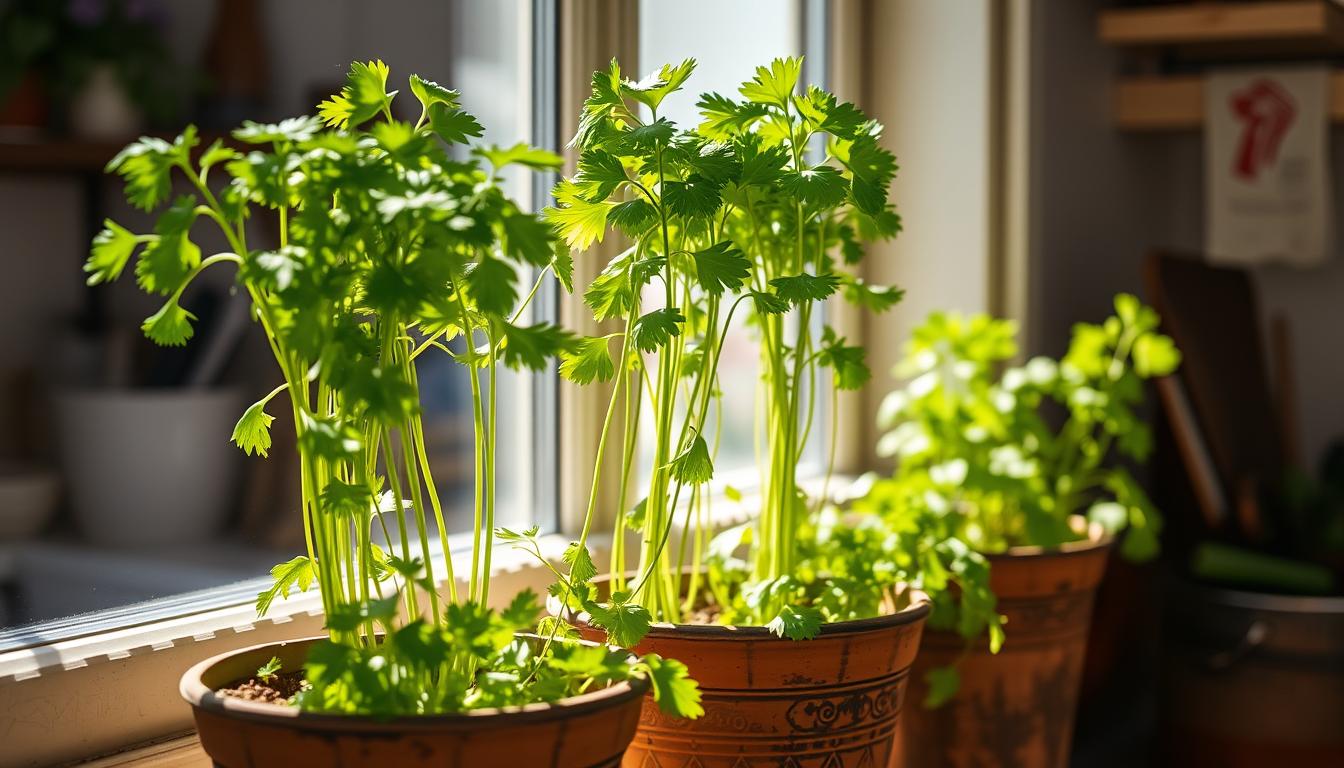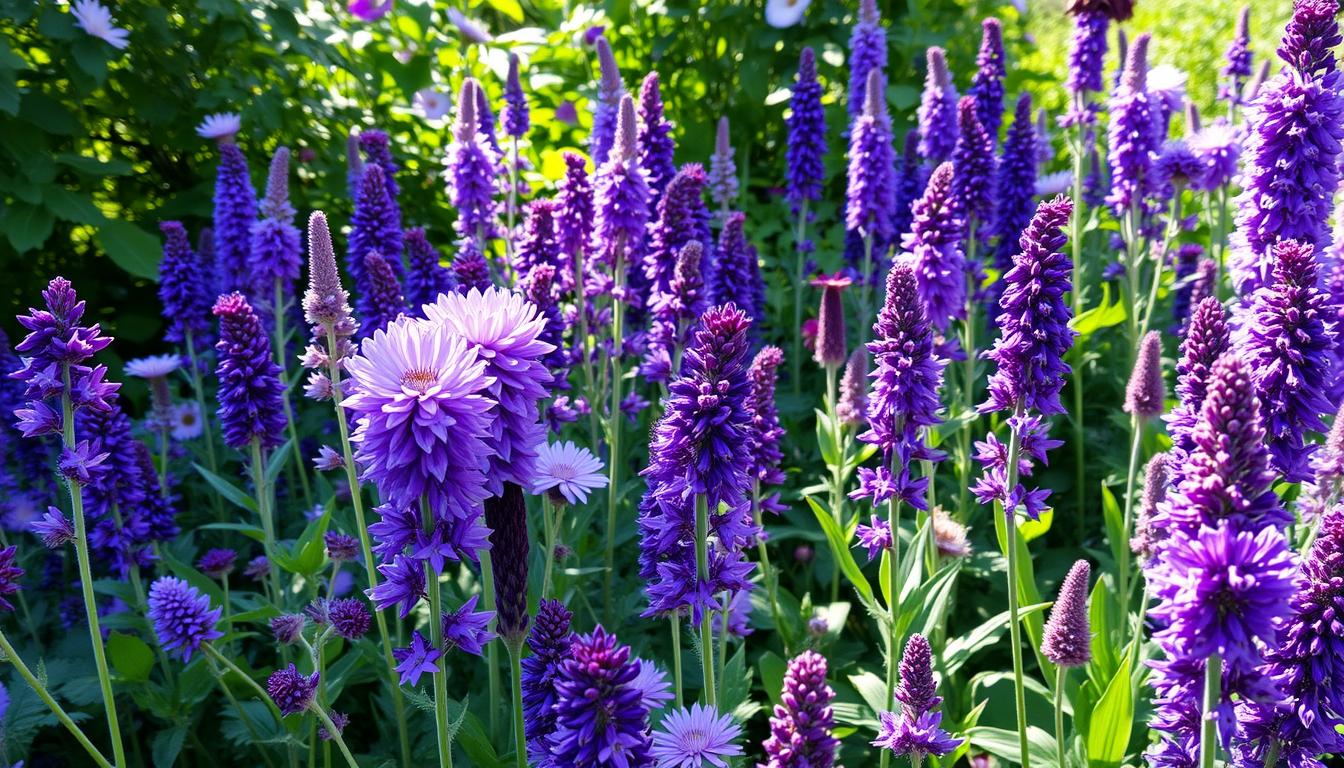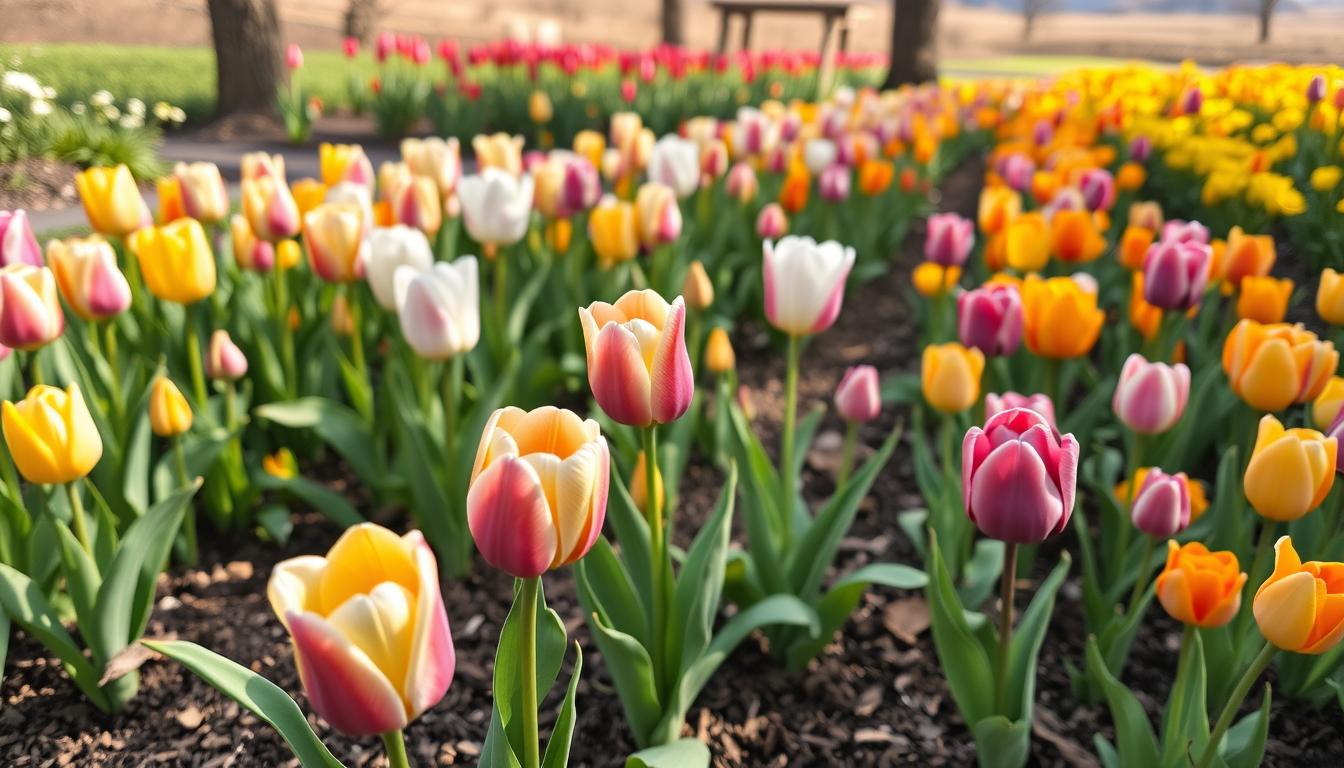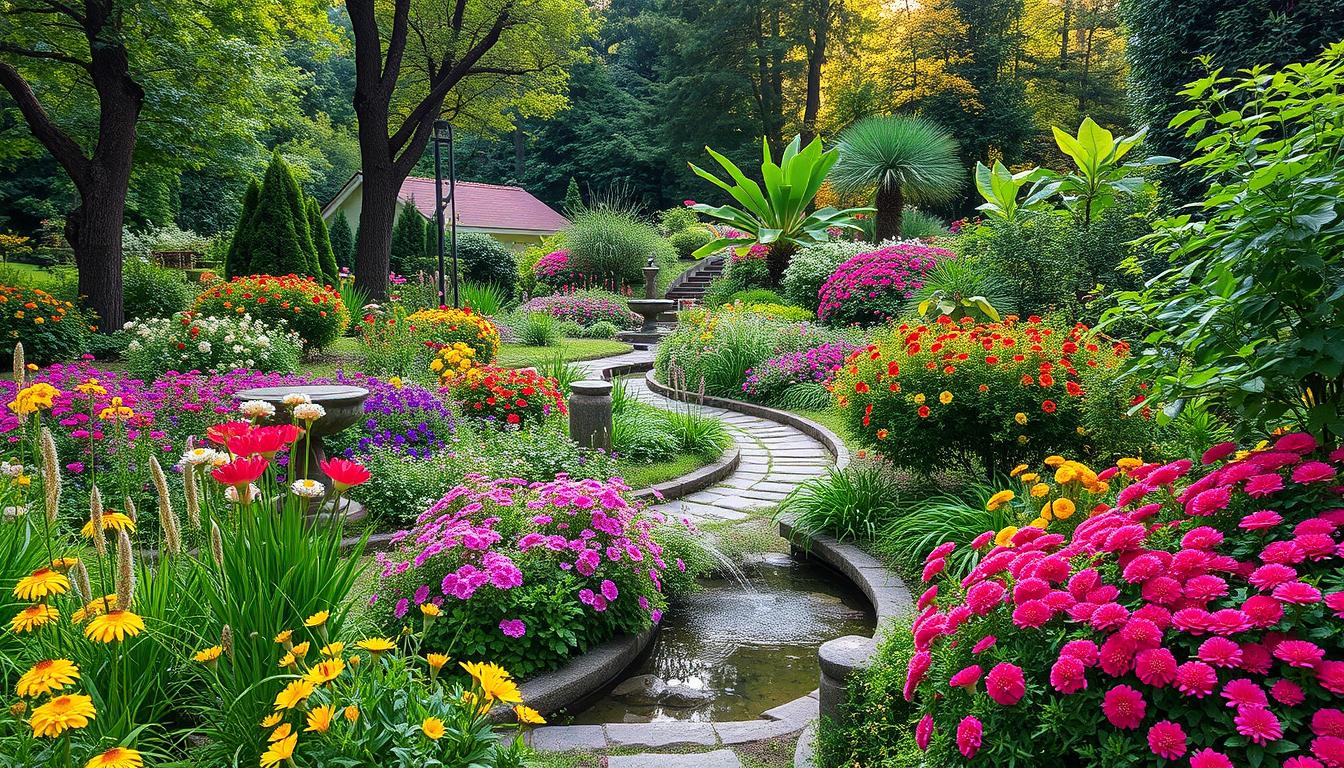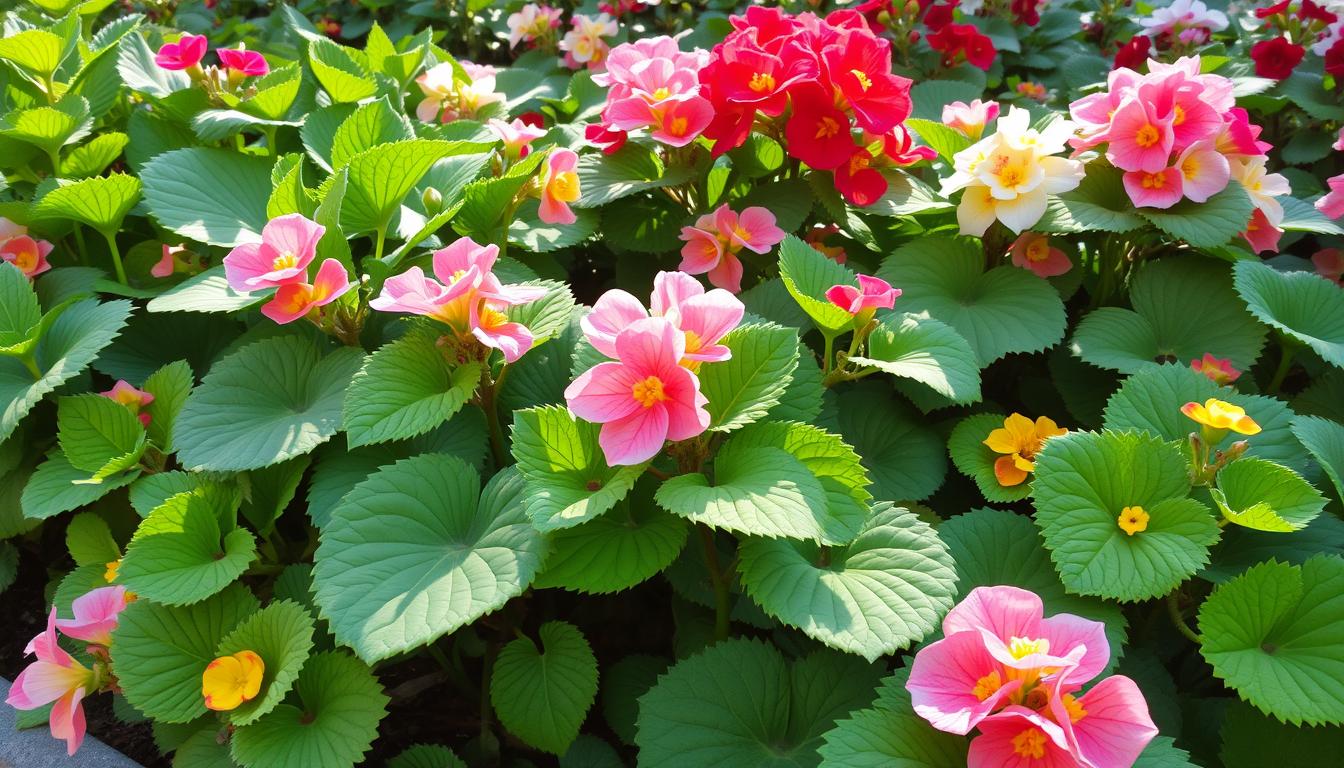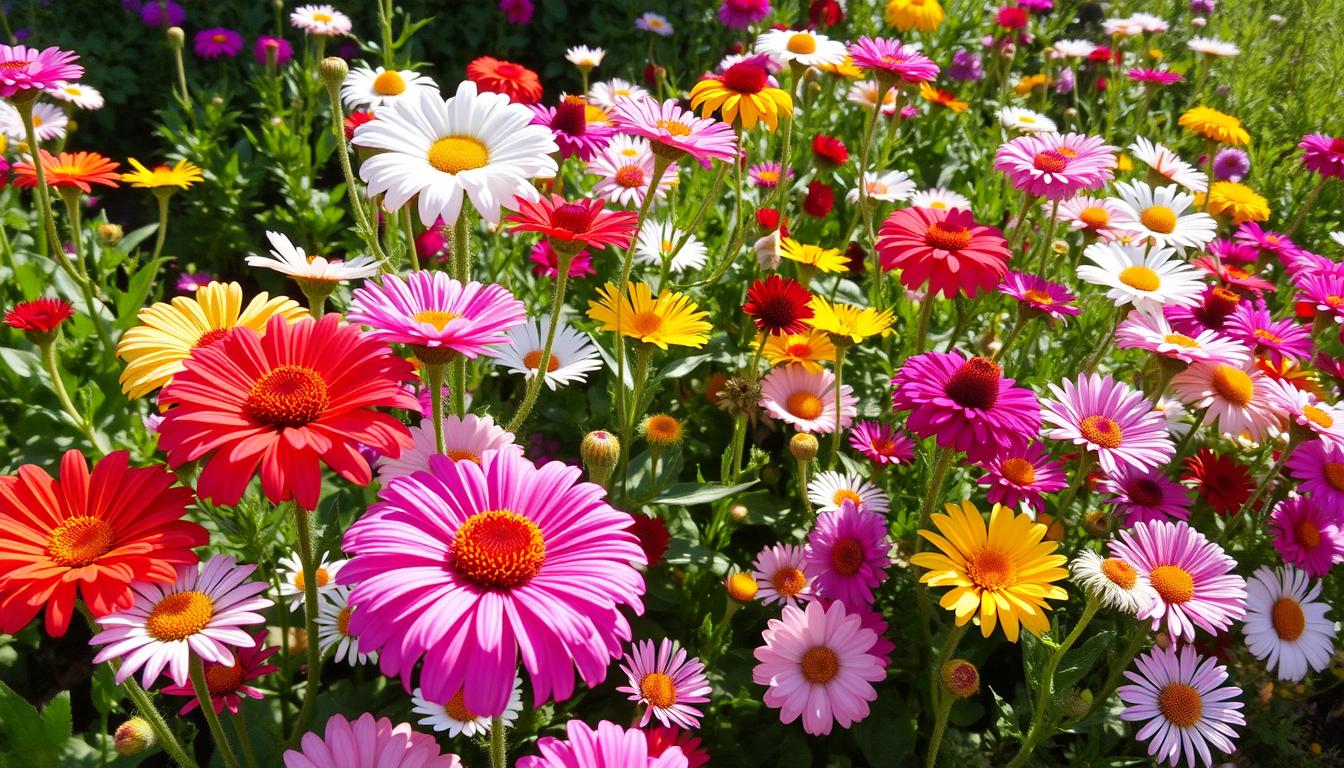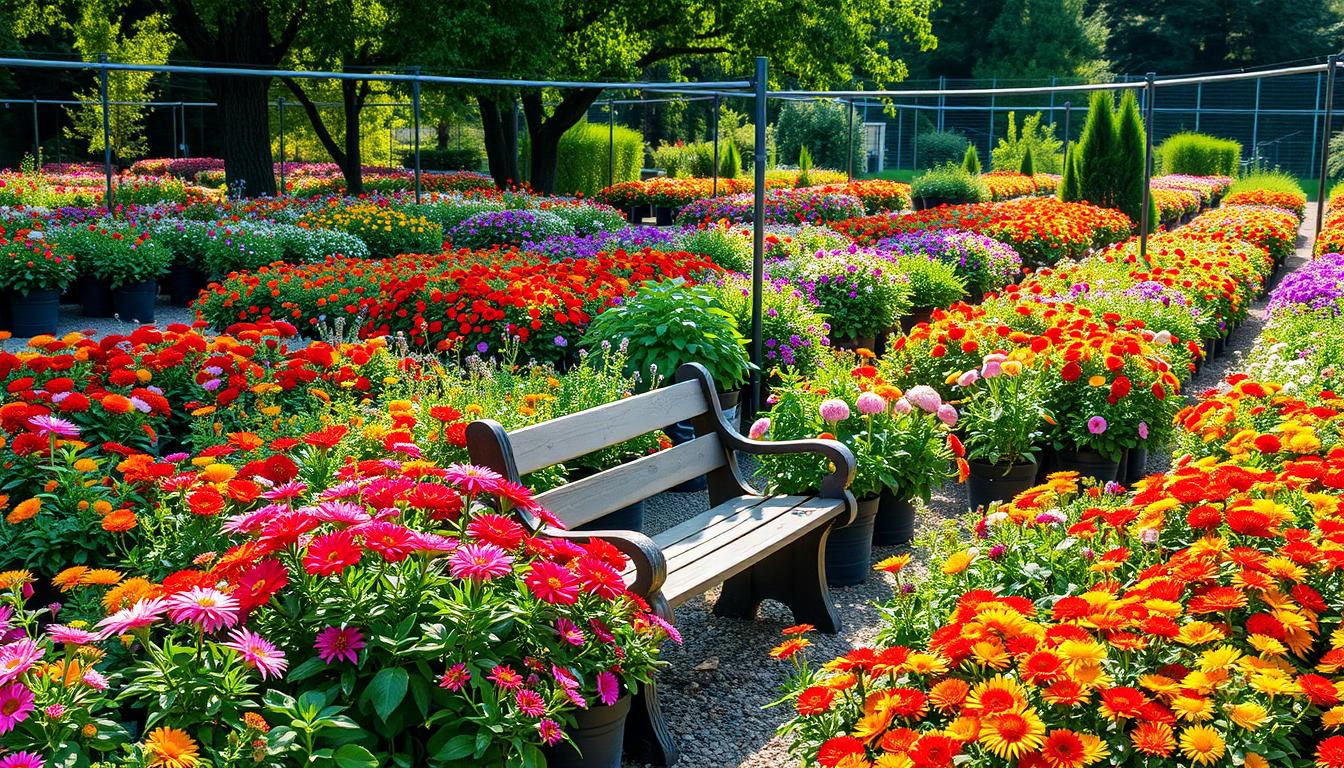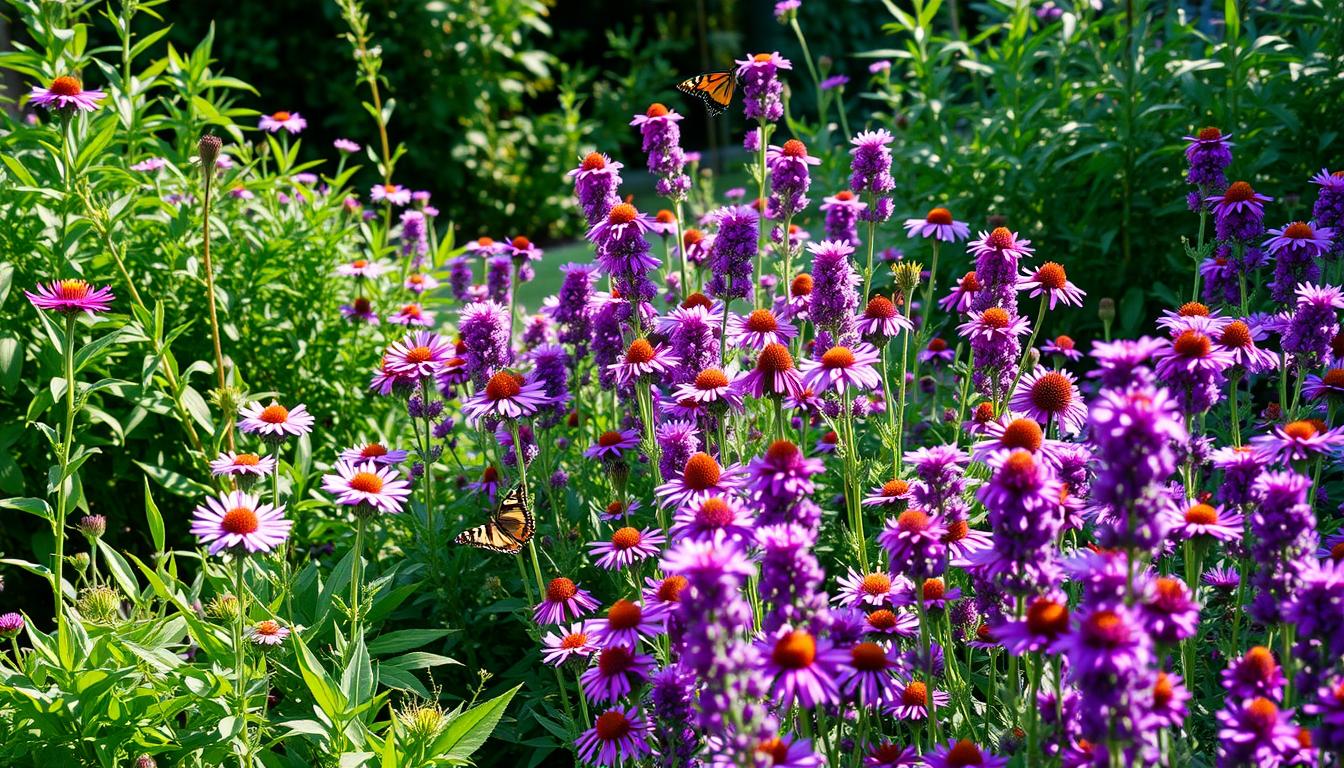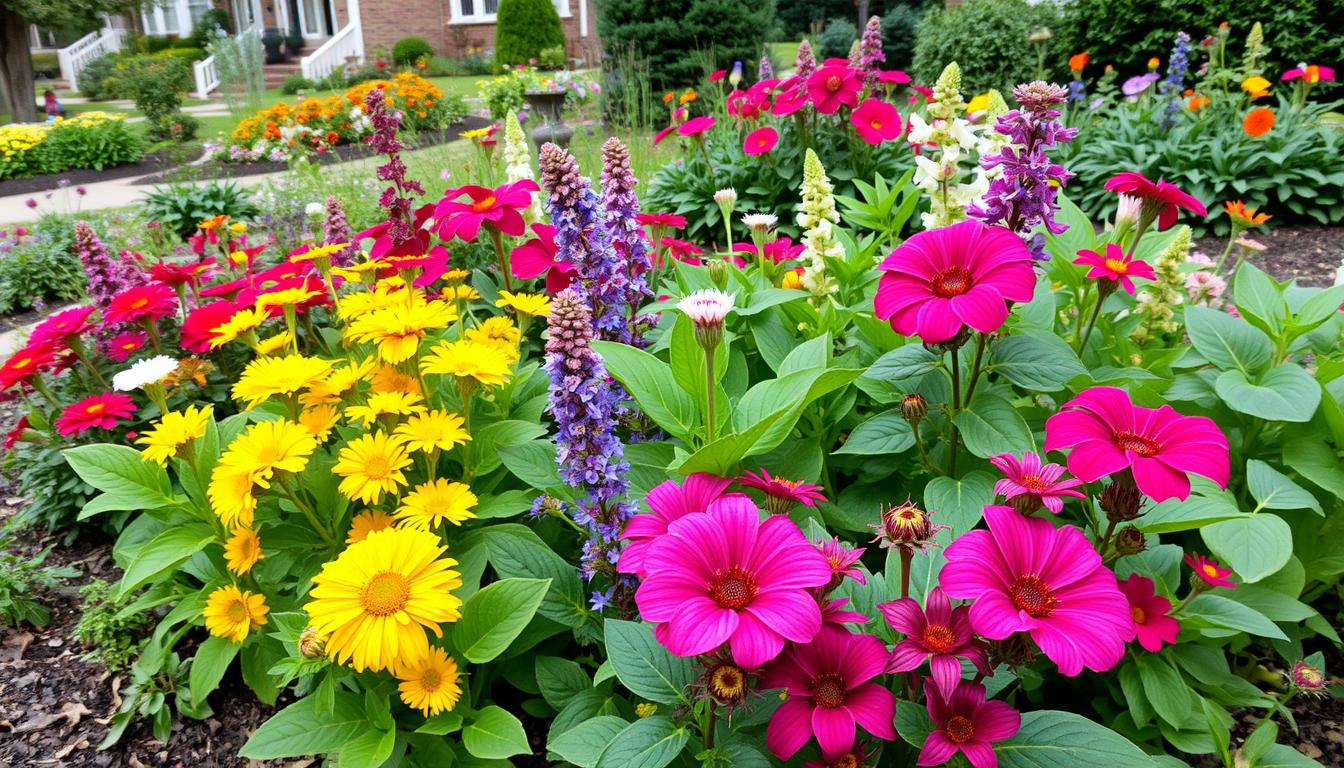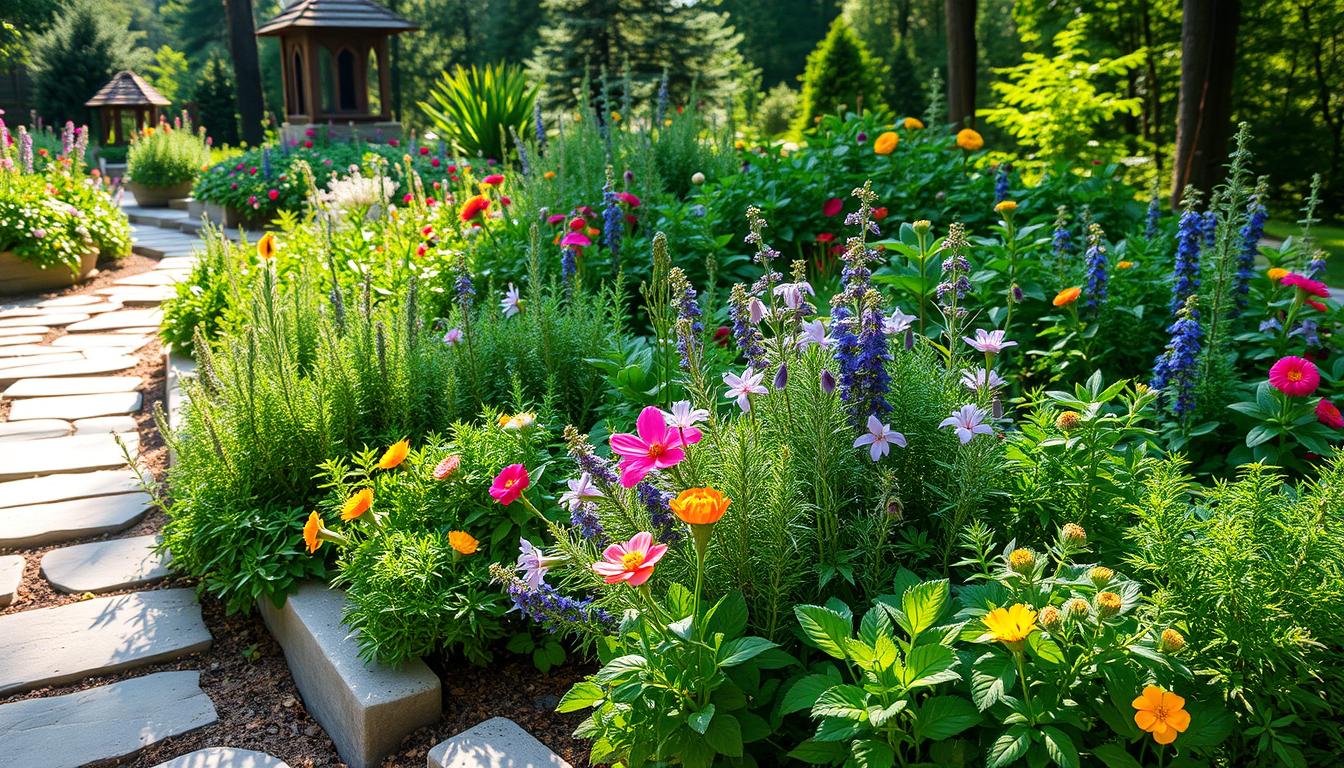How To Grow Cilantro Coriander Indoors ? Do you remember that first time you tasted fresh cilantro in your favorite salsa? Growing cilantro indoors can bring that vibrant flavor into your kitchen. It changes your cooking and connects you with nature’s bounty.
Indoor coriander planting is more than a hobby. It’s a way to have fresh herbs all year. Whether you love cooking or are new to gardening, growing cilantro indoors opens up a world of possibilities.
This guide will show you how to create your own herb sanctuary. You’ll learn how to pick the best seeds and care for your plants. You’ll see how easy and rewarding indoor gardening can be.
Growing cilantro indoors means you can have fresh, organic herbs anytime. No more expensive store-bought packages or wilted greens. With the right techniques, you’ll have a thriving herb garden that makes your meals zestier and your home happier.
Table of Contents
Benefits of Growing Cilantro Indoors
Growing cilantro indoors can transform both your cooking and health routines. By having fresh cilantro readily available, you can enhance the flavor of your meals while also benefiting from its nutritional properties. It’s a perfect addition for home gardeners who enjoy cultivating plants in limited spaces, as well as for cooking enthusiasts who appreciate fresh, homegrown ingredients. Cilantro is known for its vitamins, antioxidants, and potential health benefits, making it a valuable herb to have in your kitchen for both culinary and wellness purposes.
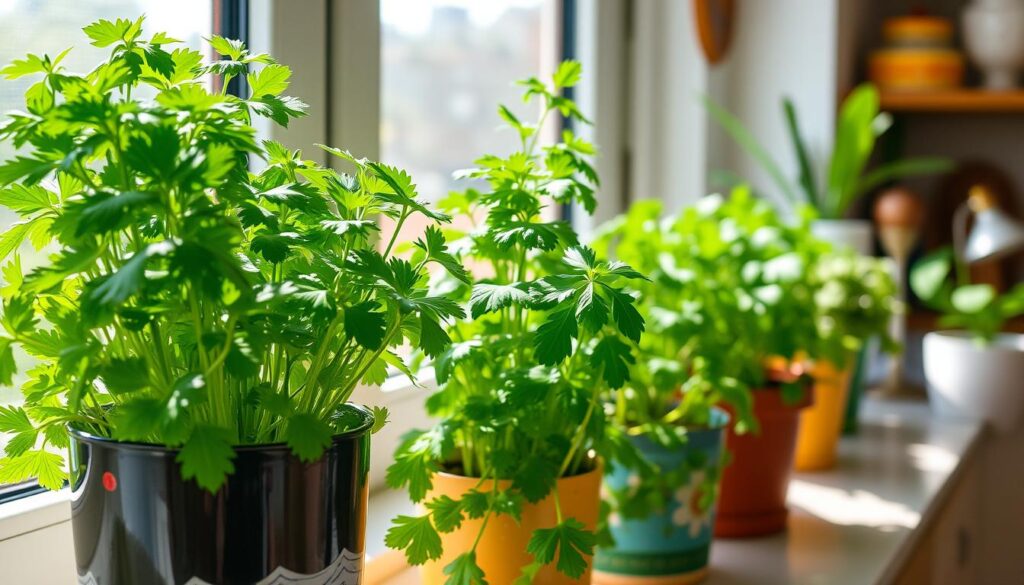
Fresh Flavor in Your Cooking
Starting to grow coriander indoors opens up new flavors. Fresh cilantro makes dishes taste better than store-bought herbs. It’s perfect for:
- Mexican and Latin American dishes
- Salsa and guacamole
- Garnishing soups and salads
- Asian stir-fries and curries
Health Benefits of Cilantro
Indoor cilantro is not just tasty; it’s also very healthy. It’s full of nutrients that are good for you:
| Nutrient | Health Benefit |
|---|---|
| Vitamin A | Supports eye health |
| Vitamin K | Promotes bone strength |
| Antioxidants | Reduces inflammation |
Year-Round Harvesting
One big plus of growing cilantro indoors is harvesting all year. You don’t have to worry about the weather outside. You can control the growing conditions for a steady supply of fresh herbs.
“Growing cilantro indoors is like having a fresh herb garden at your fingertips, 365 days a year.” – Culinary Herb Enthusiast
Choosing the Right Pot and Soil
Growing cilantro indoors needs careful thought about your container and soil. To get the best Indoor Cilantro Harvesting, create a perfect spot for your herbs. The right pot and soil mix can greatly help your plant’s health and growth.
Selecting the Ideal Pot for Cilantro
When picking a pot for your cilantro, look for these important features:
- Minimum depth of 8 inches to support root development
- Multiple drainage holes to prevent water logging
- Wide enough to allow multiple plants if desired
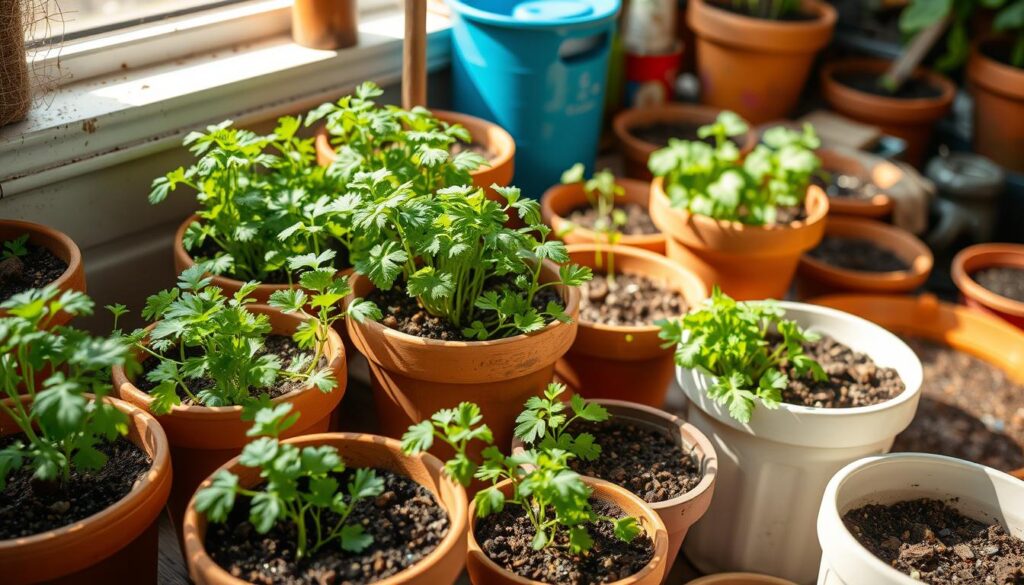
Soil Composition for Optimal Growth
For the best Indoor Cilantro Growing Practices, you need a special soil mix. Your cilantro will do best in a light, nutrient-rich mix that drains well.
| Soil Component | Percentage | Purpose |
|---|---|---|
| Organic Potting Soil | 60% | Provides base nutrients |
| Compost | 30% | Adds rich organic matter |
| Perlite | 10% | Improves drainage |
Pro tip: Avoid heavy clay soils that retain too much water, which can cause root rot and slow growth.
“The secret to thriving indoor cilantro is creating a soil environment that mimics its natural growing conditions.” – Herb Gardening Experts
Ideal Indoor Conditions for Cilantro
Growing cilantro indoors needs careful attention to the environment. To make your herb thrive, create the perfect atmosphere. Knowing what cilantro needs is key to successful indoor gardening.
Lighting Essentials for Healthy Growth
Cilantro loves bright, indirect sunlight. Place your plant near a window that gets 6-8 hours of gentle light each day. If natural light is scarce, grow lights are a great backup.
- Place near east or west-facing windows
- Avoid direct afternoon sunlight
- Use LED grow lights if natural light is insufficient
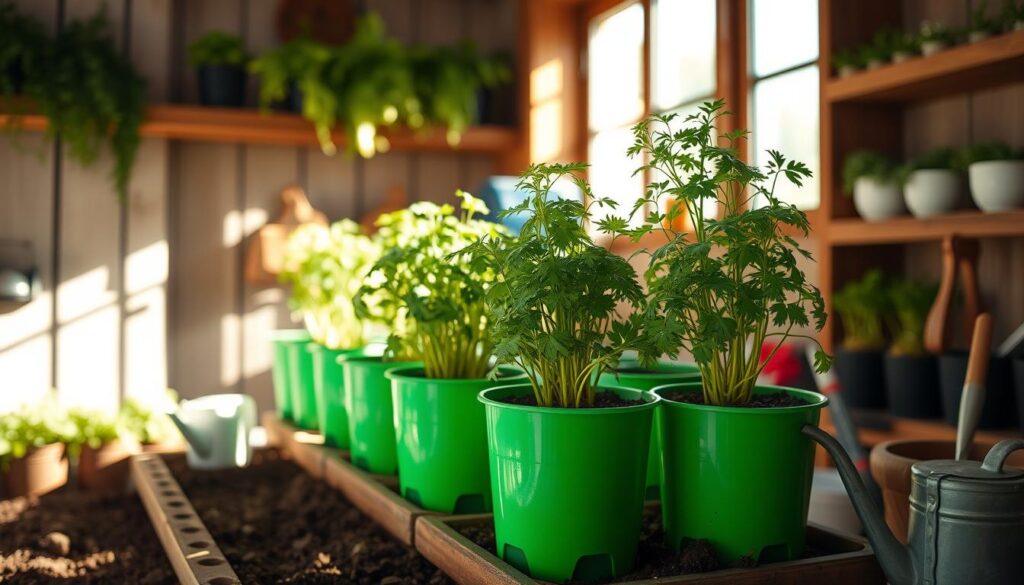
Temperature and Humidity Management
For cilantro to thrive indoors, maintaining the proper temperature and humidity is essential. Cilantro is native to regions with moderate temperatures and a certain level of humidity, so replicating these conditions indoors helps the plant grow strong and healthy. Ideal temperatures for cilantro are between 65-75°F (18-24°C), and the humidity should not be too dry. Keeping your indoor environment in these ranges ensures cilantro can grow quickly and produce fresh, flavorful leaves, just like it would in its natural outdoor habitat.
| Condition | Optimal Range | Care Recommendation |
|---|---|---|
| Temperature | 60-70°F (15-21°C) | Keep away from drafts and heating vents |
| Humidity | 40-50% | Mist leaves or use a humidity tray |
Pro tip: Use a digital thermometer and humidity meter to check your cilantro’s environment closely. Small changes can greatly improve your plant’s health and yield.
“The secret to thriving indoor herbs is creating a microclimate that mimics their native growing conditions.” – Herb Cultivation Expert
Planting Cilantro Seeds or Seedlings
Growing cilantro indoors is a great way to have fresh herbs all year. Your Indoor Coriander Planting Guide starts with the best ways to begin your herb garden. You can start with seeds or seedlings.

When learning to grow cilantro indoors, you have various methods to choose from based on your gardening experience and available resources. For beginners, starting with seeds in pots or containers is simple and effective. More experienced gardeners might try growing cilantro using hydroponic systems or in self-watering planters. The key is selecting a method that aligns with your skills, space, and what you have on hand. Whether you’re working with a small windowsill or a larger indoor space, picking the right approach ensures success in growing healthy cilantro.
Starting from Seeds
Cilantro seeds need special care to grow well. Here are the key steps:
- Choose high-quality, fresh cilantro seeds from trusted garden suppliers
- Find a shallow container with holes for drainage
- Use a light, well-draining potting mix made for herbs
- Plant seeds about 1/4 inch deep in moist soil
Transplanting Seedlings
If you want a quicker start, transplanting seedlings is a good choice.
| Seedling Transplanting Stage | Recommended Action |
|---|---|
| Seedling Height | 2-3 inches tall |
| Spacing | 3-4 inches apart |
| Root Handling | Gentle removal to prevent root damage |
| Soil Preparation | Loose, nutrient-rich potting mix |
Pro tip: Minimize root disturbance during transplanting to ensure healthy cilantro growth.
By following these tips, you’ll create a thriving cilantro garden. It will give you fresh herbs right in your kitchen.
Watering Cilantro Correctly
Growing coriander indoors needs careful watering. It’s key to keep your cilantro plants healthy and full of leaves. Learning how much water they need is important for a good harvest.

Understanding Moisture Needs
Cilantro requires a balanced amount of water to thrive. It likes to be kept consistently moist but not overly saturated. Overwatering can cause the roots to rot, while underwatering can lead to dry, wilted leaves. The key is finding the right balance where the soil stays moist but not waterlogged. You can tell when cilantro needs water by observing the soil—if it feels dry a couple of inches down, it’s time to water. Your plants will also show signs of thirst, such as wilting leaves or a dull appearance, indicating it’s time for a drink.
Signs of Overwatering
- Yellowing leaves show root stress
- Stems that wilt even with wet soil
- Soil that stays soggy and doesn’t drain
- Fungal growth near the base of the plant
Best Practices for Watering
- Feel the top inch of soil to check moisture
- Water when the top soil is dry
- Use water at room temperature
- Water right at the plant’s base
| Watering Frequency | Soil Condition | Action Required |
|---|---|---|
| Every 3-4 days | Top inch dry | Gentle watering |
| Less frequent | Consistently moist | Reduce watering |
“Consistent moisture is the secret to thriving indoor cilantro plants.” – Gardening Expert
By following proper watering techniques, you can help your cilantro thrive indoors. However, each plant is unique, so it’s important to observe how your cilantro responds to the water you give it. If the leaves start wilting or the soil dries out quickly, you may need to adjust your watering schedule. Similarly, if the soil stays too wet and the plant looks stressed, you might need to water less. Regularly check your plants and adapt based on their needs to ensure they stay healthy and grow well.
Fertilizing Your Indoor Cilantro
Proper fertilization is key for growing great indoor cilantro. Cilantro needs the right nutrients for strong growth and tasty leaves.
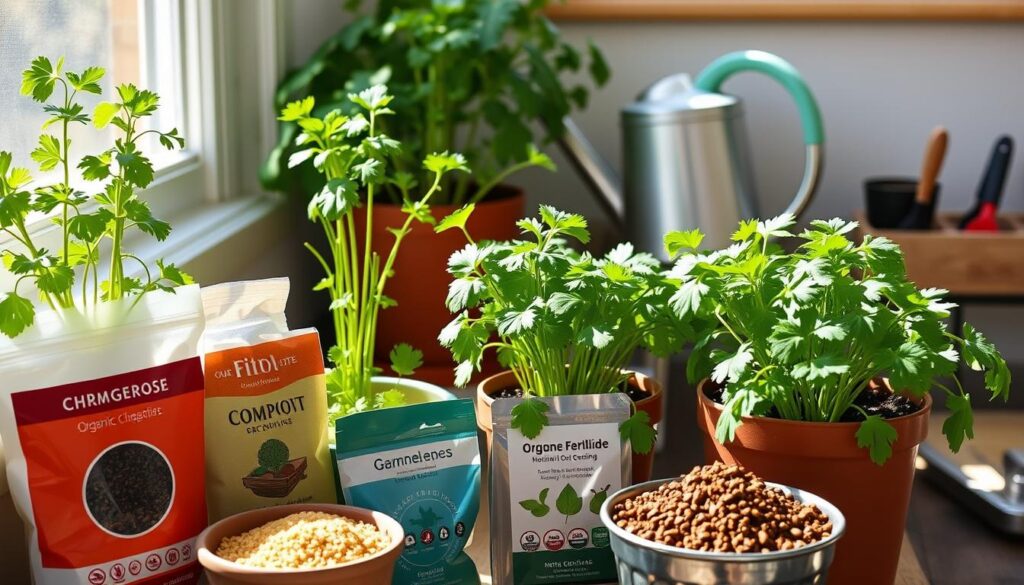
Choosing the right fertilizer is crucial for healthy cilantro growth indoors. Fertilizers provide essential nutrients like nitrogen, phosphorus, and potassium, which cilantro needs to grow strong and produce vibrant leaves. Using a balanced, organic fertilizer or a slow-release formula ensures your plant gets a steady supply of nutrients without overfeeding, which could harm the plant. The right fertilizer promotes healthier root development and more flavorful leaves, giving you a thriving cilantro plant to enjoy in your kitchen.
Selecting the Best Fertilizer
Your indoor cilantro needs balanced nutrition. Here are some good fertilizer options:
- Balanced water-soluble fertilizers
- Organic liquid fertilizers
- Diluted compost tea
- Fish emulsion
Application Frequency and Techniques
Fertilizing indoor cilantro needs care. Here’s how to do it right:
- Dilute fertilizers to half-strength
- Apply every 4-6 weeks during active growth
- Avoid over-fertilizing to maintain leaf flavor
- Stop fertilizing during dormant periods
“The key to great cilantro is balanced nutrition without overwhelming the plant’s delicate flavor profile.” – Herb Growing Expert
Pro tip: Organic fertilizers often provide gentler nutrition for your indoor cilantro, helping maintain its delicate taste and aroma.
Pruning and Harvesting Cilantro
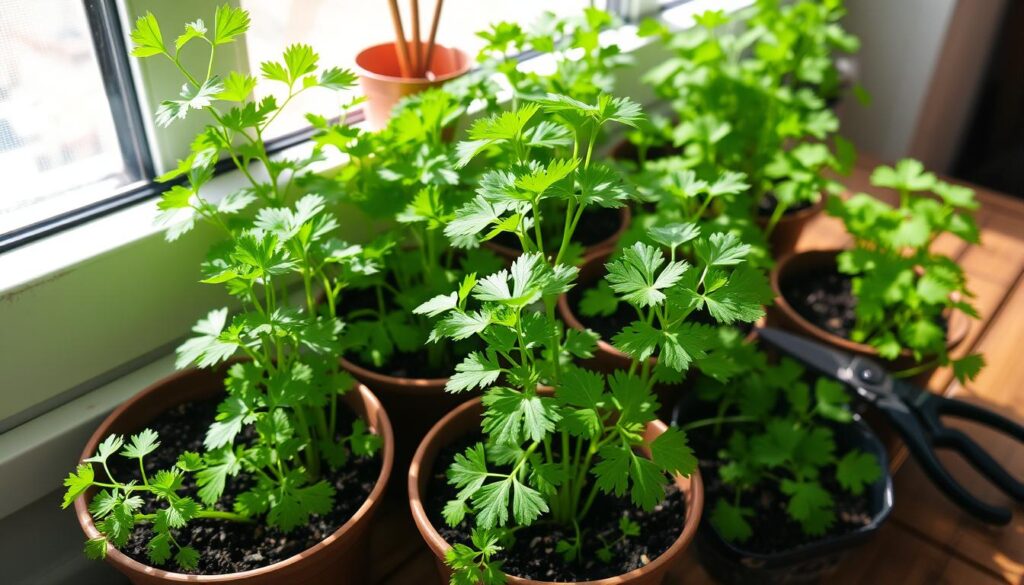
Learning to prune and harvest is key for growing cilantro indoors. Your cilantro needs careful care to grow well and taste great in your cooking.
When to Begin Pruning
Start pruning your cilantro when it’s about 6 inches tall. Trimming it right helps it grow fuller and healthier. Your goal is to help it grow strong while keeping it healthy.
- Wait until plants reach 6 inches in height
- Focus on removing outer leaves first
- Leave inner leaves to continue growing
Expert Harvesting Tips
Harvesting well is key to keeping your cilantro growing. Follow these tips to get the most from your plant:
- Use clean, sharp scissors for precise cutting
- Harvest no more than 1/3 of the plant at once
- Cut leaves close to the stem base
“The secret to abundant cilantro is gentle, consistent harvesting that respects the plant’s natural growth cycle.” – Herb Gardening Experts
By using these tips, you’ll have a steady supply of fresh cilantro from your indoor garden. Remember, gentle pruning and careful harvesting are the secrets to a thriving herb plant.
Common Pests and Diseases
Growing cilantro indoors means you need to watch out for pests. Knowing what pests can harm your plants is key to growing healthy herbs.
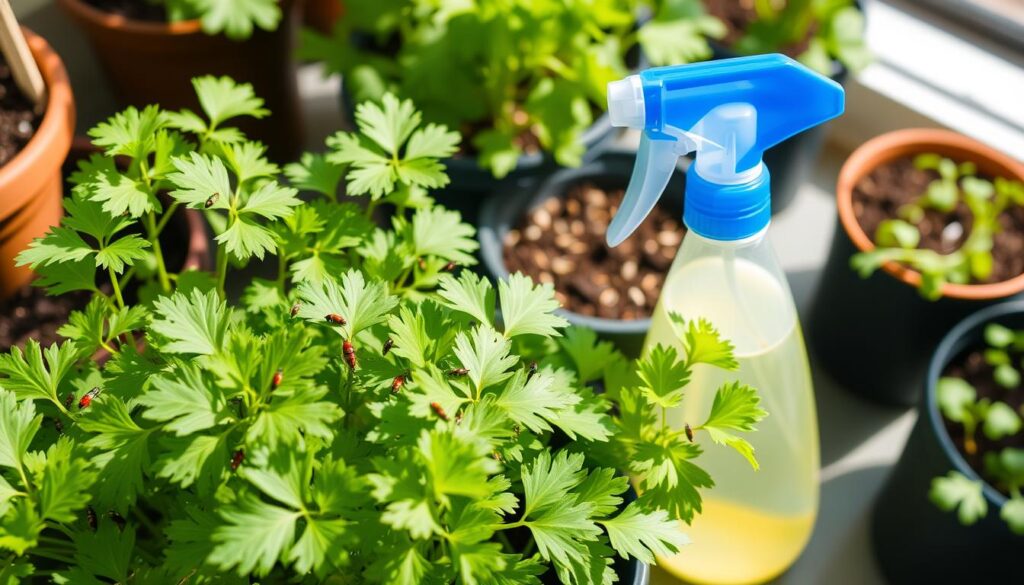
Identifying Common Pests
Indoor cilantro can attract pests that harm your plants. Here are some common ones to look out for:
- Aphids: Tiny green or white insects clustering on leaves
- Spider mites: Microscopic pests causing yellow stippling on foliage
- Whiteflies: Small white insects that flutter when disturbed
Organic Treatment Options
You don’t need harsh chemicals to protect your cilantro. Natural methods can keep pests away:
- Neem oil: A powerful natural insecticide
- Insecticidal soap: Gentle yet effective pest control
- Beneficial insects like ladybugs: Natural predators of harmful pests
“Prevention is always better than cure in herb gardening.” – Professional Gardener
To avoid pests and diseases, keep the air moving, don’t overwater, and check your plants often. These steps help prevent problems when growing cilantro indoors.
Tips for Maintaining Healthy Cilantro
For successful Indoor Cilantro Harvesting, you need to care for your herb garden well. Your cilantro plants need regular attention to grow strong and flavorful. By following the best indoor cilantro growing practices, you can keep a steady supply of healthy herbs.
Companion Plants for Cilantro
Planting cilantro with the right companions can boost its growth and keep pests away. Herbs like chives and basil are great with cilantro. They create a healthy environment for your plants and help fight off pests.
Rotation and Resting Periods
Rotating your cilantro every few months and giving it breaks is crucial. Plant new cilantro every 2-3 weeks for a constant supply of fresh herbs. This method prevents soil from getting too tired and helps your plants grow stronger and more flavorful.
Remember, caring for your cilantro consistently is important. With the right care, spacing, and watching, you’ll get fresh, aromatic herbs. These will make your cooking even better.

